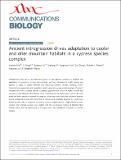Files in this item
Ancient introgression drives adaptation to cooler and drier mountain habitats in a cypress species complex
Item metadata
| dc.contributor.author | Ma, Yazhen | |
| dc.contributor.author | Wang, Ji | |
| dc.contributor.author | Hu, Quanjun | |
| dc.contributor.author | Li, Jialiang | |
| dc.contributor.author | Sun, Yongshuai | |
| dc.contributor.author | Zhang, Lei | |
| dc.contributor.author | Abbott, Richard John | |
| dc.contributor.author | Liu, Jianquan | |
| dc.contributor.author | Mao, Kanghan | |
| dc.date.accessioned | 2019-07-10T11:30:05Z | |
| dc.date.available | 2019-07-10T11:30:05Z | |
| dc.date.issued | 2019-06-18 | |
| dc.identifier | 259546956 | |
| dc.identifier | 5859a65b-2ca0-4998-b5b3-0ef9d35bd325 | |
| dc.identifier | 000472461200002 | |
| dc.identifier | 85071164557 | |
| dc.identifier.citation | Ma , Y , Wang , J , Hu , Q , Li , J , Sun , Y , Zhang , L , Abbott , R J , Liu , J & Mao , K 2019 , ' Ancient introgression drives adaptation to cooler and drier mountain habitats in a cypress species complex ' , Communications Biology , vol. 2 , 213 . https://doi.org/10.1038/s42003-019-0445-z | en |
| dc.identifier.uri | https://hdl.handle.net/10023/18066 | |
| dc.description | Funding: This work was supported by the National Natural Science Foundation of China (grant numbers 31590821, 31622015, 31370261), the National Basic Research Program of China (grant number 2014CB954100), Sichuan Provincial Department of Science and Technology (grant number 2015JQ0018) and Sichuan University (Fundamental Research Funds for the Central Universities, SCU2019D013, SCU 2018D006) | en |
| dc.description.abstract | Introgression may act as an important source of new genetic variation to facilitate the adaptation of organisms to new environments, yet how introgression might enable tree species to adapt to higher latitudes and elevations remains unclear. Applying whole-transcriptome sequencing and population genetic analyses, we present an example of ancient introgression from a cypress species (Cupressus gigantea) that occurs at higher latitude and elevation on the Qinghai-Tibet Plateau into a related species (C. duclouxiana), which has likely aided the latter species to extend its range by colonizing cooler and drier mountain habitats during postglacial periods. We show that 16 introgressed candidate adaptive loci could have played pivotal roles in response to diverse stresses experienced in a high-elevation environment. Our findings provide new insights into the evolutionary history of Qinghai-Tibet Plateau plants and the importance of introgression in the adaptation of species to climate change. | |
| dc.format.extent | 12 | |
| dc.format.extent | 1577674 | |
| dc.language.iso | eng | |
| dc.relation.ispartof | Communications Biology | en |
| dc.subject | GE Environmental Sciences | en |
| dc.subject | QH301 Biology | en |
| dc.subject | QH426 Genetics | en |
| dc.subject | DAS | en |
| dc.subject | SDG 13 - Climate Action | en |
| dc.subject.lcc | GE | en |
| dc.subject.lcc | QH301 | en |
| dc.subject.lcc | QH426 | en |
| dc.title | Ancient introgression drives adaptation to cooler and drier mountain habitats in a cypress species complex | en |
| dc.type | Journal article | en |
| dc.contributor.institution | University of St Andrews. School of Biology | en |
| dc.identifier.doi | https://doi.org/10.1038/s42003-019-0445-z | |
| dc.description.status | Peer reviewed | en |
This item appears in the following Collection(s)
Items in the St Andrews Research Repository are protected by copyright, with all rights reserved, unless otherwise indicated.

